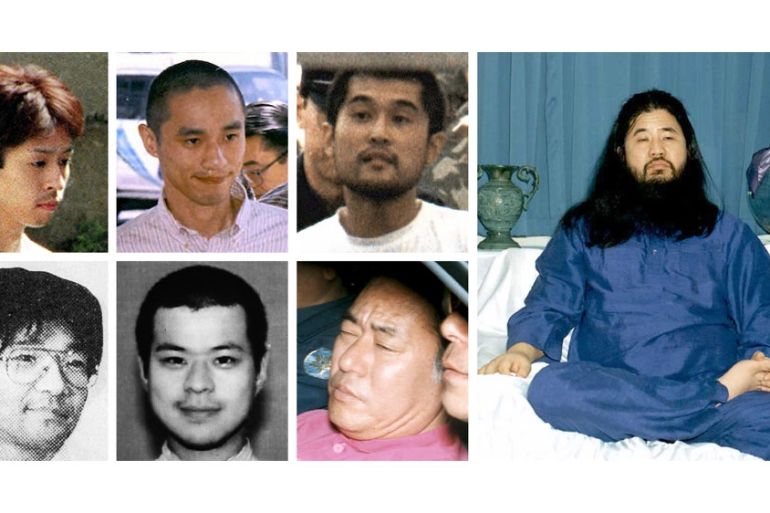Japan hangs doomsday cult members who attacked subway with sarin
The 1995 attack by the Aum Shinrikyo group on Tokyo subways killed 13 people and injured more than 6,000 others.

Doomsday cult leader Shoko Asahara and six of his followers have been executed for their roles in a deadly 1995 gas attack on Tokyo subways and other crimes, closing a chapter on one of Japan‘s most shocking crimes in recent memory.
Japan’s justice ministry confirmed reports that Asahara, who founded the Aum Shinrikyo group, and his followers had been hanged on Friday.
Keep reading
list of 4 itemsPalestinian Prisoner’s Day: How many are still in Israeli detention?
‘Mama we’re dying’: Only able to hear her kids in Gaza in their final days
Europe pledges to boost aid to Sudan on unwelcome war anniversary
Asahara and five of the six executed were implicated in the subway attack, which occurred during the morning rush hour of March 20, 1995, when members of the Aum Shinrikyo cult punctured plastic bags to release sarin nerve gas inside subway cars, killing 13 people and sickening more than 6,000.
The cult also carried out other crimes that together with the subway attack killed 27 people in total. Six other followers remain on death row.
Japan’s justice minister, who approved the hangings, said she doesn’t take executions lightly but felt they were justified in this case because of the unprecedented seriousness of the crimes.
“The fear, pain and sorrow of the victims, survivors and their families – because of the heinous cult crimes – must have been so severe, and that is beyond my imagination,” Justice Minister Yoko Kamikawa told a news conference.
She said the crime did not only affect Japan but also sowed fear abroad.
“This gave me a peace of mind,” Kiyoe Iwata, who lost her daughter in the subway attack, told Japanese broadcaster NHK. “I have always been wondering why it had to be my daughter and why she had to be killed. Now, I can pay a visit to her grave and tell her of this.”
Asahara, whose original name was Chizuo Matsumoto, founded Aum Shinrikyo, or Supreme Truth, in 1984. Over the years, the group managed to lure in followers from some of Japan’s top universities and boasted some 10,000 followers in Japan and another 30,000 in Russia.
The group amassed an arsenal of chemical, biological and conventional weapons to carry out Asahara’s escalating criminal orders in anticipation of an apocalyptic showdown with the government.
During his eight-year trial, Asahara spoke incoherently, occasionally babbling in broken English, and never acknowledged his responsibility or offered meaningful explanations.
He was on death row for about 14 years. His family said he was a broken man, constantly wetting and soiling the floor of his prison cell and not communicating with his family or lawyers.
![Asahara, whose name was Chizuo Matsumoto, founded Aum Shinrikyo, or Supreme Truth, in 1984 [Yoshikawa Joh/EPA]](/wp-content/uploads/2018/07/6f8ebf3019844fbaa47ab4d10fa3b9cf_18.jpeg)
Amnesty International lamented the executions, saying that they failed to deliver justice and were “the ultimate denial of human rights”.
Urged by the UN’s Human Rights Council in 2008 to abolish the death penalty, Japan said it could not go against public opinion which favoured the measure for “extremely vicious crimes”.
Chief Cabinet Secretary Yoshihide Suga said authorities are taking precautionary measures in case of any retaliation by Asahara’s followers.